
Bugs Bunny is a fictional character created in the late 1930s at Warner Bros. Cartoons and voiced originally by Mel Blanc. Bugs is best known for his featured roles in the Looney Tunes and Merrie Melodies series of animated short films, produced by Warner Bros. Earlier iterations of the character first appeared in Ben Hardaway's Porky's Hare Hunt (1938) and subsequent shorts before Bugs's definitive characterization debuted in Tex Avery's A Wild Hare (1940). Bob Givens, Chuck Jones, and Robert McKimson are credited for defining Bugs's design.

Daffy Duck is a fictional character created by animators Tex Avery and Bob Clampett for Leon Schlesinger Productions. Styled as an anthropomorphic black duck, he has appeared in cartoon series such as Looney Tunes and Merrie Melodies, in which he is usually depicted as a foil for either Bugs Bunny, Porky Pig or Speedy Gonzales. He was one of the first of the new "screwball" characters that emerged in the late 1930s to replace traditional everyman characters who were more popular earlier in the decade, such as Mickey Mouse, Porky Pig, and Popeye.

Hippety Hopper is a young kangaroo character in the Warner Bros. Looney Tunes series of cartoons. Robert McKimson introduced Hippety Hopper in Hop, Look and Listen (1948), which established the pattern for future Hippety Hopper cartoons. The character appeared in 14 theatrical cartoons between 1948 and 1964.

The Goofy Gophers are animated cartoon characters in Warner Bros.' Looney Tunes and Merrie Melodies series of cartoons. The gophers are small and brown with tan bellies and buck teeth. They both have British accents. Unnamed in the theatrical cartoons, they were given the names Mac and Tosh in the 1960s TV show The Bugs Bunny Show. The names are a pun on the surname "Macintosh". They are characterized by an abnormally high level of politeness.

Cecil Turtle is a fictional character in the Warner Bros. Looney Tunes and Merrie Melodies series of films. Though he made only three theatrical appearances, Cecil has the unusual distinction in that he is one of the very few characters who were able to outsmart Bugs Bunny, and the only one to do so three times in a row and at the rabbit's own game. Cecil often gives Bugs the taunting nickname of "Speedy" when addressing the rabbit.

Hillbilly Hare is a 1950 Warner Bros. Merrie Melodies cartoon directed by Robert McKimson. The short was released on August 12, 1950 and stars Bugs Bunny.
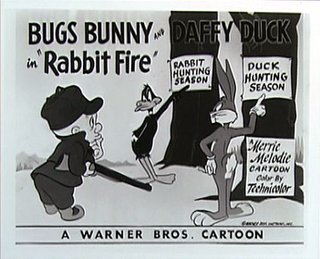
Rabbit Fire is a 1951 Looney Tunes cartoon starring Bugs Bunny, Daffy Duck, and Elmer Fudd. Directed by Chuck Jones and written by Michael Maltese, the cartoon is the first in Jones' "hunting trilogy"—the other two cartoons following it being Rabbit Seasoning and Duck! Rabbit, Duck! It is also the first cartoon to feature a feud between Bugs and Daffy. Produced by Edward Selzer for Warner Bros. Cartoons, the short was released to theaters on May 19, 1951 by Warner Bros. Pictures and is often considered among Jones' best and most important films.

Tortoise Wins by a Hare is a Merrie Melodies cartoon released on February 20, 1943, and directed by Bob Clampett. It stars Bugs Bunny and Cecil Turtle. It is a sequel to 1941's Tortoise Beats Hare, with footage from said cartoon briefly shown at the beginning. It is also the first short to feature Robert McKimson's design of Bugs Bunny.

Looney Tunes Golden Collection: Volume 1 is a DVD box set that was released by Warner Home Video on October 28, 2003. The first release of the Looney Tunes Golden Collection DVD series, it contains 56 Looney Tunes and Merrie Melodies cartoons and numerous supplements. The set won the Classic Award at the Parents' Choice Awards.

French Rarebit is a 1951 Warner Bros. Merrie Melodies animated short, directed by Robert McKimson and written by Tedd Pierce. Released June 30, 1951, the cartoon features Bugs Bunny. The title is a play on "Welsh rarebit", which is also known as "Welsh rabbit".

Easter Yeggs is a 1947 Looney Tunes theatrical animated short. The cartoon was released on June 28, 1947, and features Bugs Bunny and Elmer Fudd. The title is a play on "Easter eggs" and on "yegg", a slang term for a burglar or safecracker. The voice and characterization of the Easter Bunny in the short is a reference to a character that Mel Blanc performed on the Burns and Allen radio show, the morose Happy Postman, even including the character's catch phrase, "Remember, keep smiling."

Acrobatty Bunny is a 1946 Warner Bros. Looney Tunes short directed by Robert McKimson. The short was released on June 29, 1946, and stars Bugs Bunny and Nero the Lion. This was the first cartoon McKimson directed that starred Bugs Bunny.
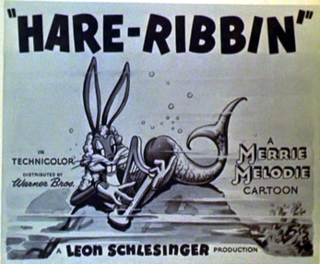
Hare Ribbin' is a 1944 animated short film in the Merrie Melodies series, directed by Robert Clampett and featuring Bugs Bunny. The plot features Bugs' conflict with a red-haired hound dog, whom the rabbit sets out to evade and make a fool of using one-liners, reverse psychology, disguises and other tricks. It was released in theaters by Warner Bros. on June 24, 1944. The title is a pun on "hair ribbon".
Bugs Bunny's Thanksgiving Diet is an animated television special that aired November 15, 1979 on CBS. It stars Bugs Bunny and incorporated parts of several Looney Tunes cartoons. The special followed up on the successful Looney Tunes special Bugs and Daffy's Carnival of the Animals that had aired in 1976, which reintroduced the character of Bugs Bunny in his first new material since 1964.
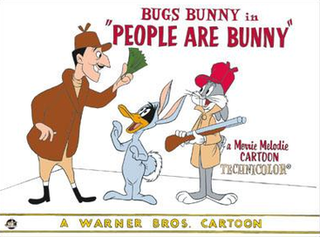
People Are Bunny is a 1959 Warner Bros. Merrie Melodies cartoon, directed by Robert McKimson The short was released on December 19, 1959, and stars Bugs Bunny and Daffy Duck.

The Grey Hounded Hare is a 1949 Looney Tunes short film made by Warner Bros. Pictures and starring the voice talent of Mel Blanc. The film stars Bugs Bunny. It was directed by Robert McKimson, and animated by John Carey, Phil DeLara, Manny Gould and Charles McKimson, with music scored by Carl Stalling. The title refers to the greyhounds of the plot as well as "hounded" meaning pestered or pursued relentlessly.
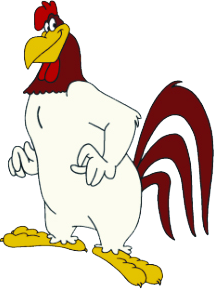
Foghorn Leghorn is an anthropomorphic rooster who appears in Looney Tunes and Merrie Melodies cartoons and films from Warner Bros. Animation. He was created by Robert McKimson, and starred in 29 cartoons from 1946 to 1964 in the golden age of American animation. All 29 of these cartoons were directed by McKimson.
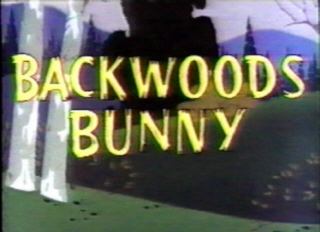
Backwoods Bunny is a 1959 Warner Bros. Merrie Melodies cartoon, directed by Robert McKimson and written by Tedd Pierce. The short was released on June 13, 1959, and stars Bugs Bunny.

















